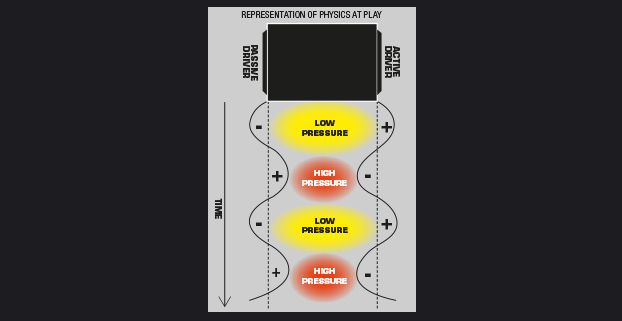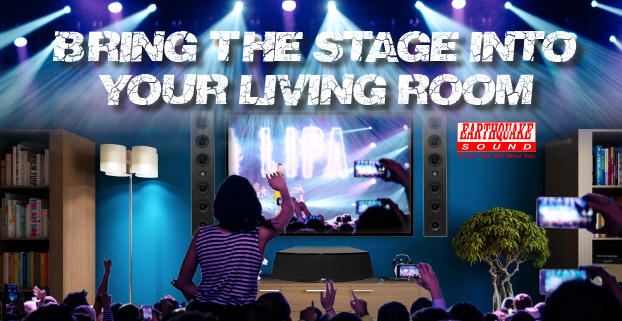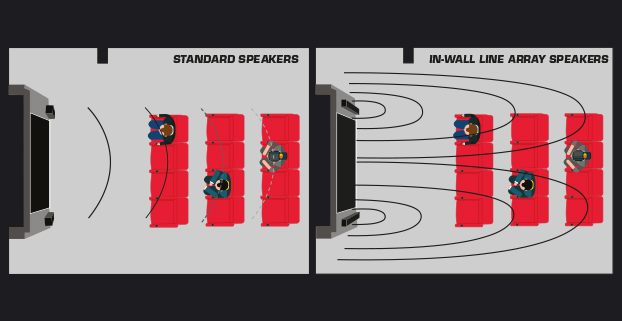Joseph Sahyoun is the head honcho of Earthquake and also one of the most eccentric engineers that you’re likely to meet, but before we start talking about Joseph, let’s rewind. We visited Earthquake Sound on a beautiful, sunny San Francisco day in September. Earthquake is based near the bay in Hayward, a stone’s throw from the rapidly expanding Silicon Valley. Staff are busy building the product and since it’s still a family business, the Sahyoun sons and Joseph’s brother Abraham are organising shipments, working on new software DSPs and at the same time speaking with distributors in both China and Canada.
Only a week before, we had met Joseph at CEDIA in San Diego, California. In typical Joseph style, he launched into a wildly technical explanation; never bothering to ask who we were, and whether or not we understood what he was explaining.
Fixing all audio problems
A week later, Joseph rambles into the office, bluntly asking what we were doing there. I said that we’re here to learn more. Earthquake Sound is one of the most profitable brands for many of our clients, so maintaining this involves continual education. Joseph, bored by my chatter, yells to a passing colleague, “Bring me a Humkleaner”. He grabs the product and pliers it open. I came to understand that Joseph would do this to any product that came into his possession. In fact, on that visit, he plied open the Voltage Reducer (model HLLC200), a pair of Beats headphones and even a HP printer cartridge.
With the box now open, he proclaims “This is the best headphone accessory.” From what I understood of his explanation, the lifting of the earth (floating earth) and pre-amplification, made the Humkleaner a great headphone preamp. I explained that we had success in the commercial PA market for removing ground loops.
He’s excited to hear that it has solved these issues and immediately launches into other applications, asking about impulse noise. He’s rarely interested in your answer and more interested in explaining his point. One end of the unbalanced [RCA] connection is floating and one end is grounded making it ideal for long audio runs. The loss of voltage is a big issue when running larger distances. In this case, the hefty preamp in the Humkleaner boosts the signal voltage, while at the equipment end, the HLLC200 Voltage Reducer drops the signal back to line level. The HLLC200 has a left and right output, but also a GND, B+ and REM output. These additional outputs can be used as a DC trigger. With the addition of a 12V DC power supply, it can be used to automatically turn on equipment that’s in a remote location. The Humkleaner and HLLC200 are designed to fix a whole array of audio issues.
HUMKLEANER – TWO CHANNEL CONVERTER
HLLC200 LINE OUT CONVERTOR – FOUR CHANNEL SIGNAL OUTPUTS
A crash course in speakers
Earthquake Sound is world renowned for their subwoofers, but listening to Joseph, I realised that these guys are sound engineers at heart. He had a remarkable ability to explain speaker fundamentals, so here are a few golden gems that I gleaned from his mad scientist rant.
TITAN THEIA – CENTRE CHANNEL SPEAKER
Earthquake line array
Line Arrays are used to disperse sound through the room. This makes Line Array technology ideal for LCR (left, centre, right) configurations in home theatre as the sound is highly directional. It also copes well with various viewing distances. If a home theatre has seating in rows, you must use Line Array speakers to keep sound levels consistent throughout the room.
EWS600 – 6.5″ EDGELESS INWALL SPEAKER (PAIR)
EWSLA63 – IN-WALL LINE ARRAY LCR SPEAKER (SINGLE)
The earthquake DJ Quake is also an example of Line Array technology. People seated close to the speakers receive sound from the first (bottom) speaker. People furtherest away will hear a similar SPL level, as they receive sound from all 4 speakers, as represented below. Earthquake were saying that their Chinese distributor supplies the Line Array speakers on their own to large restaurants. These restaurants position a few arrays on the walls, which disperses sound evenly around the large space. They use independent subwoofers if they need extra bass reinforcement.
If you’d like to use Earthquake for special projects, then let us know. They are happy to accommodate, however since the product comes from San Francisco, we will need sufficient notice.
DJQUAKE2.1 – DJ QUAKE SET BUILT-IN 1000W AMPLIFIER
DJQUAKE2.1V2 – DJ QUAKE SET VERSION 2
Ceiling speakers for DTS-X and Dolby Atmos
ACS3.0 – 3″ CEILING SPEAKER CLOSED BACK (SINGLE)
Object based DSPs, like Atmos or DTS-X, tend to involve 2 or 4 dedicated ceiling speakers to deal with all the overhead action in movies. When viewing movies like Alien: Covenant, you would hear the dripping from the roof of the cave or space craft flying overhead. These new immersive digital sound modes are fantastic with viewers having a sensation of being in the middle of the movie. When Dolby first released Atmos, we were told that ‘normal’ ceiling speakers are fine. 6 years on and Joseph is on a crusade, explaining that speakers like the ACS3.0 are a better choice when compared to larger speakers, like the ECS6.5 or ECS8.0. He was enthusiastically saying that he expects something from Dolby shortly, confirming Earthquake’s findings. The ACS3.0 is cheaper than the bigger ECS8.0, but as Joseph’s brother Abraham explains, he’s first and foremost an engineer. The business aspects need to often take a backseat!
Passive radiator design, XJ amplification & earthquake’s new DSP
We all know that watching movies without subwoofers should be a jail-able offence, but by the same token, we’re increasingly seeing some pretty lacklustre Chinese and Taiwanese subs hitting the market. Some of these manufacturers have gained some global notoriety, though Joseph wasn’t lauding praise on them.
In the subwoofer world, there’s a healthy amount of argument about whether subs should be ported or sealed. Joseph believes that passive radiators are the best design and he is more than willing to prove it. Passive radiator designs are not the sole property of Earthquake. Their Californian counterparts at Sunfire also do a fantastic job building powerful subs in a small form factor. This design produces a fantastic amount of power due to a kind of momentum between the speaker driver and the radiator.
 The passive radiator design is very efficient in its own right, but Earthquake also employ highly efficient Class XJ amplification. Class XJ amplification borrows aspects of both Class D digital amplification and Class B analogue amplification.
The passive radiator design is very efficient in its own right, but Earthquake also employ highly efficient Class XJ amplification. Class XJ amplification borrows aspects of both Class D digital amplification and Class B analogue amplification.
During our recent visit to Earthquake, we saw the new Minimep67 redesign. The passive radiators are now disguised behind sleek cabinetry. They also showed us their MK commercial sub. The MK guts are the same, but it now features a hard wearing, commercial cabinet.
If you punch in this URL https://bit.ly/2NFTiw0, you’ll see a Supernova MKVII subwoofer in slo-mo operating at 16Hz. 16Hz is below the hearing spectrum for humans, though the big Earthquake subs maybe one of just a few in the world that perform without any damage to the speaker or cabinet.
We also got our first hands-on experience with their new DSP. Using your iOS or Android device, you pair with your MINIME or MK sub via Bluetooth.
The sub then makes a bunch of noises, much like when you perform the set up of home theatre amplifiers. The frequency response is measured 3 times. From there, you can manage the acoustics of the room. In our case, it adjusted the phase and flattened the EQ without us having to move the subwoofer. This DSP will allow users to place the subwoofer in the most convenient location and the App will do the rest. While the App is simple, there is also a paid Pro version with additional functionality.
The final discussion involved the unique DSP in all current MK subwoofers. Joseph was saying that 2 or 4 MK subs are ideal for most home cinema rooms. The MK sub should be connected to the subwoofer output of your AV receiver. Users are also encouraged to connect their Front Left and Front Right preout to each subwoofer. The preouts are attenuated by 3dB, so the MK will give the user a degree of soundstage and yet also provide the room with an even dispersion of sound.
MKVII15FF & MKVII12FF – SUPERNOVA MKVII SUBWOOFER
Power
Technologies such as audio formats, DSPs, channels and processing may change every year, but every speaker requires a power supply. This power comes from either an [integrated] AV receiver or a power amp. Whichever option you choose, remember, you can never have too much power. Earthquake knows this, hence the reason why they supply us with the most powerful amplifiers in their category. “Matching” amplifiers to speakers inevitably leads to clipping and burnt out speaker coils.
Imagine a sine wave. As you push a standard amplifier to its limit, it’ll max out or “clip”. That sine wave will be flattened, sending a constant voltage to the speaker coil. Cheaper speakers, in particular, will have smaller coils, less heat dispersion and glues that cannot cope with high temperatures. The result will be a blown speaker. No distortion for a warning, just a destroyed speaker.
 If you had a powerful amplifier connected to small speakers, you could potentially destroy the speakers, but they will distort well before damage occurs. So imagine a hot light bulb. Whether the light bulb is 100W or 60W, you can tap it repeatedly without burning yourself. No damage is done. If the amplifier is clipping, its like wrapping your hand around that light bulb. Eventually, you’ll burn yourself. Earthquake also use digital amplification which is lightweight and efficient. XJ300, XJ700 and XJ1000 digital amps are used to power outdoor speakers, additional zones, or even transducers (aka seat shakers). The analogue toroidal amps are used for home theatre. They sound amazing and give even inefficient speakers dynamics that need to be witnessed. Unfortunately, in the home theatre world, power and weight are inextricably linked, so installing a Cinenova is a two person job!
If you had a powerful amplifier connected to small speakers, you could potentially destroy the speakers, but they will distort well before damage occurs. So imagine a hot light bulb. Whether the light bulb is 100W or 60W, you can tap it repeatedly without burning yourself. No damage is done. If the amplifier is clipping, its like wrapping your hand around that light bulb. Eventually, you’ll burn yourself. Earthquake also use digital amplification which is lightweight and efficient. XJ300, XJ700 and XJ1000 digital amps are used to power outdoor speakers, additional zones, or even transducers (aka seat shakers). The analogue toroidal amps are used for home theatre. They sound amazing and give even inefficient speakers dynamics that need to be witnessed. Unfortunately, in the home theatre world, power and weight are inextricably linked, so installing a Cinenova is a two person job!
CINENOVA7B – 7CH 170W AMPLIFIER RACK-MOUNTABLE
By Michael Swann
This write-up first appeared in our Nov 2018 newsletter.


